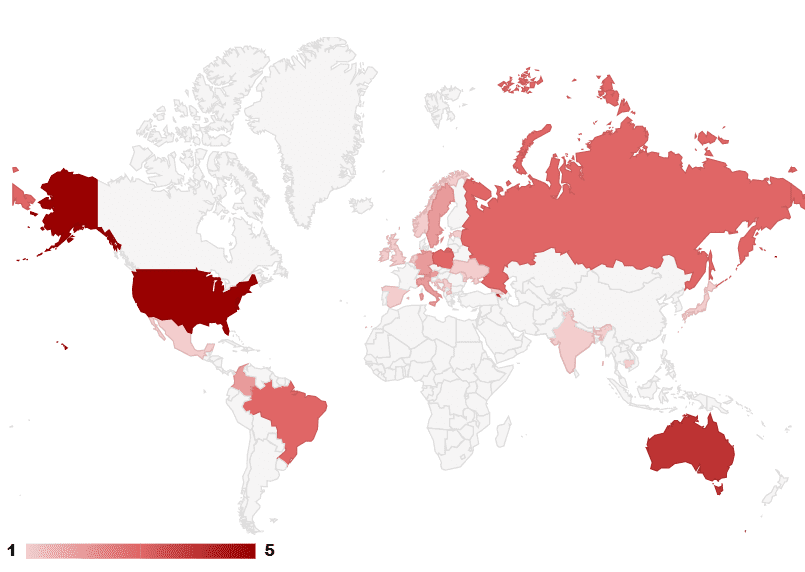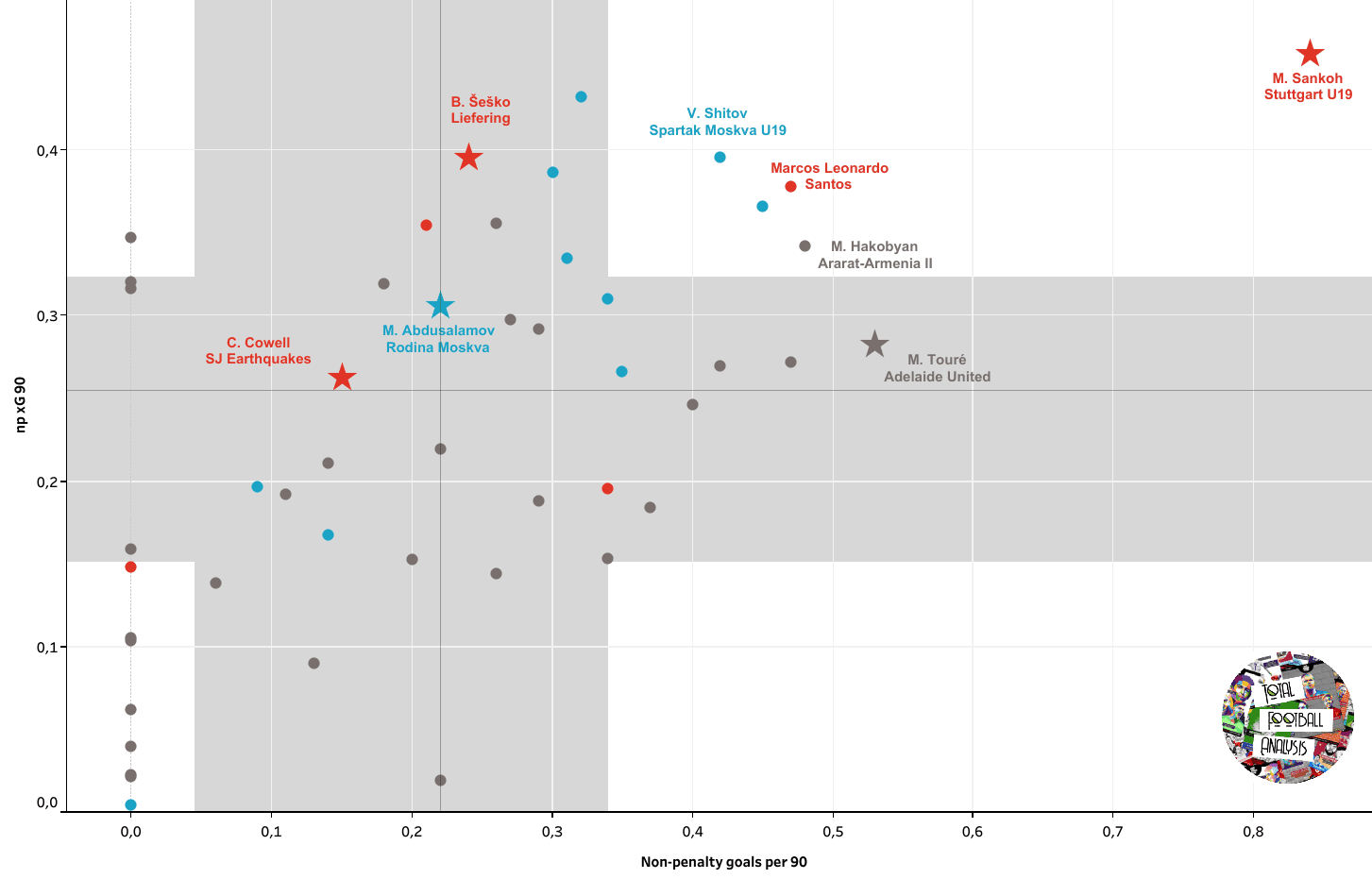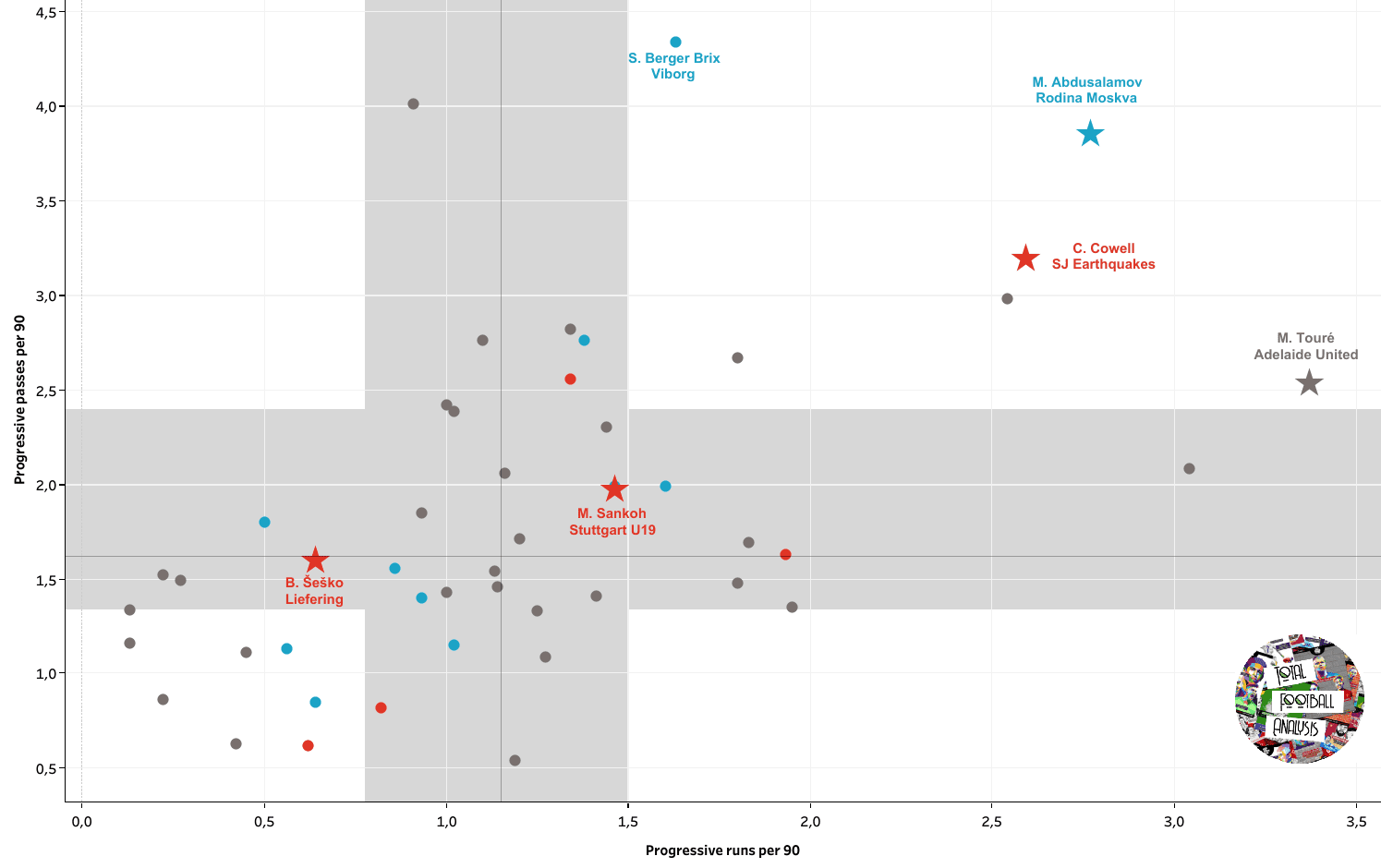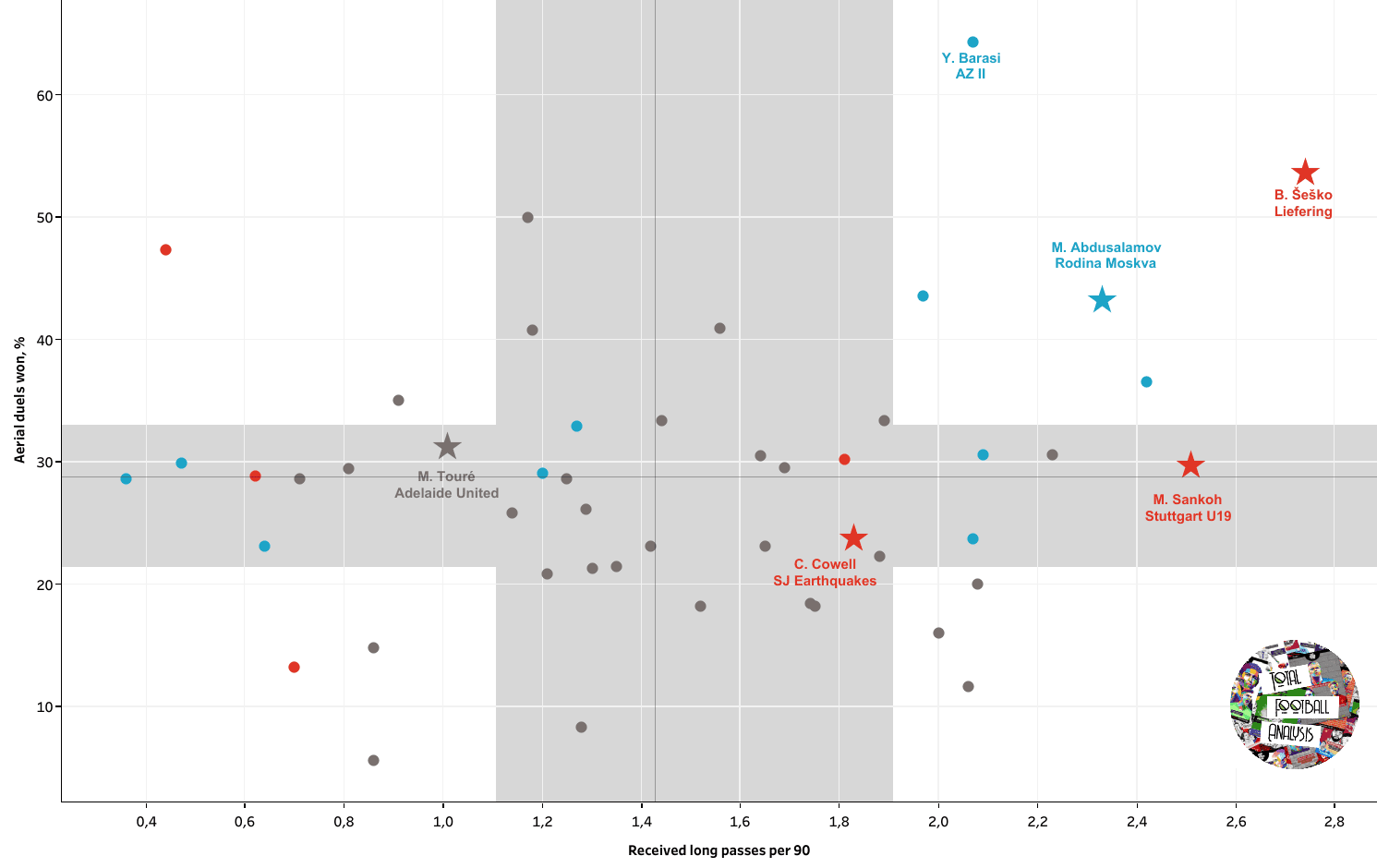Finding top talents at the earliest possible age has always been a priority for most clubs. Getting these players before they’re 18 can become an excellent source of revenue for clubs if they can develop them into top stars. Clubs like RB Salzburg have excelled at this for some years now, getting the likes of Erling Braut Haaland, Dominik Szoboszlai or Dayot Upamecano when they were still underage.
In this data analysis, we’ll look at underage players who are already playing in senior competitions in football’s most expensive position: striker. Our goal is to discover some hidden gems from all around the world who can become the next Youssoufa Moukoko, the latest star to feature for a top team while still being under 18.
Methodology
We’ve taken every striker who’s up to 17 years old who have played at least 400 minutes in the last calendar year in senior competitions all around the world and is valued by transfermarkt at less than 4 million euros. The population is composed of 49 players who play in senior leagues in the 29 countries coloured in the next map. Obviously, there are many more underage strikers playing in senior competitions worldwide but Wyscout only has enough statistics to perform a proper data analysis from these 49.

The most represented country is the USA with five players (one in the first division, three in the second and one in the third). With four players we find Armenia (all in the second division) and Australia (two in the first division and two in the second). There are three countries with three players represented: Brazil (two in the first division and one in the fourth), Poland (two in the third division and one in the fourth) and Russia (one in the second division and two in the third).
Despite the huge differences in level among these leagues, we’ll compare every player together. By doing this, we expect to find those who are really standing out at any level. We can advance that some better-known players who are already playing in good leagues won’t stand out as much as they could in this analysis but we’ll find some gems playing in relatively unexplored leagues.
In every graph, players will be coloured according to their market value taken from transfermarkt. Red means between 500,000 and 4,000,000 euros; blue means between 100,000 and 499,000 euros; and grey means less than 100,000. This is useful to know how well-known these players are as transfermarkt bases its valuations on lots of other factors apart from performance. We have selected at least one player in each category for the final shortlist.
The grey area in the graphs is the one between the 25th and 75th percentile, meaning 50% of the players fall in that area for every given metric. The thin line represents the value that leaves half of the players on each side of it.
You’ll notice the same five players are highlighted with a star in all the charts. These are the players that will make the final shortlist. By highlighting them beforehand, we can build a good understanding of their strengths and weaknesses while reading the analysis. The five shortlisted players are Benjamin Šeško (17, RB Salzburg/Liefering, €1.5M), Cade Cowell (17, SJ Earthquakes, €600k), Mohamed Sankoh (17, Stuttgart II), Magomedkhabib Abdusalamov (17, Rodina Moscow, €200k) and Mohamed Touré (16, Adelaide United, €150k). Apart from these players, there will be some other standout players annotated in each chart.
Goalscoring
The first thing everyone asks from a striker is goals. In the next graph, we can see the non-penalty xG per 90 (y-axis) and the non-penalty goals per 90 (x-axis). By taking a look at these statistics, we try to understand which strikers are getting dangerous shots, meaning their positioning and ability to get chances is good, and also how they’re finishing those chances.

The clear winner here is one of our shortlisted players, Sankoh. Scoring 0.84 non-penalty goals per 90 from 0.46 xG, Sankoh ranks first in both metrics. The 17-year-old Dutch striker plays for Stuttgart Ii in the Regionalliga Südwest, the fourth division of German football, where he has scored 9 goals in 12 matches.
In the case of Šeško, he ranks very highly in xG with 0.4 but his finishing hasn’t been the best in the last calendar year and he has only scored 0.24 goals per 90 in the Austrian 2.Bundesliga. Still, the important thing is to get into good positions and take dangerous shots and Šeško is doing that so the goals should arrive sooner than later.
In the opposite situation, we find Touré. The 16-year-old. Has scored 0.53 goals from 0.28 xG per 90. His finishing has been above average so far in the A-League and if he manages to keep a similar scoring rate he’ll be a superstar. Even if he dropped to his expected level, 0.28 goals per game is a very good figure for a young striker, especially considering Touré doesn’t always play as a pure 9.
The rest of the shortlisted players are just ok in terms of xG and goals per 90. Abdusalamov has scored 0.22 from 0.31 per 90 in the Russian PFL, the third tier, and Cowell has only scored 0.15 goals from 0.26 xG per 90 but has done it in the MLS which is a good level.
Other interesting players in this chart are Marcos Leonardo (0.47 goals from 0.38 xG for Santos in the Brazilian first division), Vladislav Shitov (0.42 goals from 0.4 xG for Spartak Moskow II in the Russian second division) and Misak Hakobyan (0.48 goals from 0.34 xG for Ararat-Armenia II in the Armenian second division).
Presence in the box and threat
Next, we’ll look at how active these strikers are inside the box and also at finishing. We’ll consider touches in the box per 90 on the y-axis and shots per 90 on the x-axis.

Levon Vardanyan, who plays for the Armenian second division club BKMA Yerevan, stands out in this chart. He’s the striker who takes the most shots with 3.35 per 90 and is also very active near the goal with 4.21 touches in the box per 90. This explains his high xG of 0.5 per 90 (the second highest in our list but unfortunately he’s underperforming them and scores just 0.39 goals per 90. Vardanyan narrowly missed out on our shortlist but he’s one to watch for sure.
In a similar situation to Vardanyan is Spartak Moscow II’s star Vladislav Shitov. The 17-year-old Russian striker takes 2.72 shots per 90 and has 4.29 touches in the box per 90. He also scores a lot as we saw in the previous section of this analysis (0.42 goals per 90) but he didn’t make it into the final shortlist either.
Looking at our shortlisted players, they all are in the top 25% for at least one of the statistics. Šeško (2.25 shots and 4.59 touches in the box per 90), Touré (2.13 and 4.02) and Sankoh (2.4 and 3.86) are in the top 25% for both, while Abdusalamov (1.97 and 3.86) and Cowell (2.28 and 3.65) are in the top 25% just for touches in the box and shots respectively, falling between the 25% and 50% in the resting metric.
Chance creation
In this part of the data analysis, we’ll look at our strikers’ ability to create chances for others and the quality of those chances. To measure this, we have chosen to show shot assists per 90 in the y-axis and expected assists in the x-axis.

One of our shortlisted players is arguably the most interesting player in this chart. Abdusalamov sets up a good number of shots (0.95 per 90) and creates dangerous situations with 0.17 xA per 90, both metrics in the top 25%. This can also explain why he doesn’t score as much as others as he seems to prefer to play in a slightly deeper role and create for others instead of being the finishing point of his team’s attacks.
Another interesting one is Emil Roback, who registered 0.22 xA per 90 (top of our strikers) with just 0.6 shots assisted per 90 playing for IK Frej Täby in the Swedish third tier last season. This means he doesn’t create as many chances but the ones he creates are very good, proving he makes good decisions and is creative when assisting his teammates. He was also very good at getting into scoring positions with 0.32 xG per 90 but he couldn’t score a single goal. He was signed by AC Milan last summer for 1.5 million euros despite being only 17 and is currently playing for their Primavera (U19) team.
Also in a very good situation but with different attributes is Caden Stafford from Philadelphia Union II. This American forward created the highest number of shots with 1.47 per 90 and his xA were in the top 25% too with 0.09 per 90. Doing this in the USL Championship, the USA second division, in 2020 was an excellent achievement, especially considering he also scored 0.37 goals per 90. Stafford has decided to join Maryland University and we’ll be playing college football for the next few seasons.
Shitov and Vardanyan appear in very good positions again here with 1.05 shot assists and 0.09 xA per 90 and 0.8 and 0.1 respectively. An interesting one because of his exotic origin is Phat Sokha from the Bati National Sports Academy in the Cambodian first division with 0.86 shot assists and 0.1 xA per 90. He also ranks quite well in progressive passes and runs with 2.3 and 1.44 per 90 respectively but he’s not good enough in the rest of the statistics to qualify for the final shortlist.
The rest of the shortlisted players’ position in this section is varied. Touré and Cowell are in the top 25% in shot assists per 90 with 0.77 and 0.76 shots assisted per 90 respectively. They’re also above average in xA per 90 with 0.08 and 0.06 per 90 respectively.
On the other side, Šeško and Sankoh rank in the bottom 25% for shots assisted per 90 with 0.32 and 0.31 and between the bottom 25% and 50% in xA per 90 with 0.02 and 0.04. This means they’re more focused on finishing their teams’ attacks than on the creation of scoring chances.
Dribbling
Here, we’ll analyze which of these strikers are capable of getting past players and dribbling. This is a very interesting trait to have for a forward to create shooting opportunities for themselves in one-on-situations and also to progress and play outside the box. In the x-axis, we show dribbles per 90 and in the y-axis, the success rate of those dribbles.

Abdusalamov is again the most interesting find here. The Russian forward ranks second in dribbles per 90 with 7.8 and first in dribbling success with 61.68%. In the previous section of this data analysis, we saw he’s a very good creator of chances with one of the highest xA per 90, so adding this information about his dribbling skills we can conclude he’s a player who likes to be in contact with the ball instead of poaching inside the box to finish the attacks. Anyway, he has good numbers in touches in the box and shots per 90, so he’s a direct player who can create and also finish the attacks.
Another of our shortlisted players comes out very good in these metrics: San José Earthquakes’ Cade Cowell. The American forward is one of the best in both statistics with 6.7 dribbles per 90 and completing 59.09% of them. He also finished lots of his attacks with 2.28 shots per 90, suggesting he creates his own chances. We shouldn’t forget he’s doing this in the MLS, which is very impressive for a 2003-born player.
Out of our shortlist, the most interesting find is Misak Hakobyan, who plays for Ararat-Armenia B in the Armenian second division. Born in 2004, this 16-year-old forward registers the most dribbles per 90 in our list with 8.47 but also completes a very high percentage of them (56.6%). Even if he’s presence in the box doesn’t stand out, he gets into good positions and is a good scorer with 0.48 goals from 0.34 xG. The Armenian second division’s level isn’t very challenging but a player putting up these numbers at just 16 is still impressive.
The rest of our shortlisted players behave quite differently. Touré attempts lots of dribbles (7.21 per 90) and completes a good but not excellent proportion of them (45.9%). Oppositely, Sankoh attempts much fewer dribbles (just 2.61 per 90) and completes an even poorer percentage (32%). In the middle ground, we find Šeško, who attempts lots of dribbles (4.51 per 90) and completes a fair but unimpressive percentage of 41.07%.
It’s interesting to note the two shortlisted players with the most presence in the box, Šeško and Sankoh, rank quite low both in assisting and dribbling skills. This suggests one more time that their role consists of finishing the attacks created by their teammates.
Progression
Another interesting characteristic to have in a striker is progressing ability. Being capable of dropping deep and taking the ball forward with runs and passes is one of the most sought after skills in the modern game. In the y-axis, we see progressive passes per 90 and in the x-axis, progressive runs per 90.

Three of our shortlisted players do very well in this department. Abdusalamov ranks third in both metrics with 3.86 progressive passes and 2.77 progressive runs per 90. We have already seen he’s a good dribbler and can assist his teammates, so this ability to progress shouldn’t surprise us.
Touré also stands out. His 3.37 progressive runs per 90 are the highest in our list and he also ranks in the top 25% for progressive passes with 2.54 per 90. His tendency to dribble and being used in slightly deeper positions as a winger explain these figures.
Cowell is the third shortlisted player that ranks in the top 25% for both metrics. With 3.2 progressive passes and 2.59 progressive runs per 90, he represented a very balanced profile when progressing the ball, which suggests he can be effectively used in the second line both in central and wide areas.
The other standout player is Sofus Berger Brix, who plays for Viborg in the Danish second division. He’s the best at progressive passes with 4.34 per 90 and can also run with the ball as proven by his 1.63 progressive runs per 90. Berger Brix also ranked very well in shots per 90 with 2.44 but doesn’t impress in the rest of the areas and seems to be a midfielder who can be used as a striker more than a proper forward.
The other shortlisted players don’t stand out in ball progression. Sankoh is in the top 50% for both metrics but not among the best with 1.98 progressive passes and 1.46 progressive runs per 90, while Šeško is in the bottom 25% for progressive runs with 0.64 per 90 and in the bottom 50% for progressive passes with 1.61 per 90.
Direct play
The last aspect we’re considering for the strikers is their suitability to play in a direct style. We’re trying to assess not only their ability to play as a classical target man who wins aerial duels (aerial duels won %, y-axis) but also their ability to run in behind and receive long passes (received long passes per 90, x-axis). Runs in behind are always difficult to measure but received long passes is an interesting proxy.

Šeško is the clear winner here. At 17, the Slovenian striker wins 53.76% of his aerial duels in the Austrian second division, which is a quite competitive league. He’s also the target of his team’s direct balls, not only to his head but also to run in behind, receiving 2.74 long passes per 90. We’ve already seen he’s very present in the box and gets into scoring positions, even if his finishing needs to get more consistent.
Abdusalamov, also shortlisted, ranks very well too. He receives 2.33 long passes per 90 and wins 43.28% of his headers. This adds to all the previous qualities we’ve seen in him, seeming to turn him into a very complete striker with the ball at his feet and also intelligent to find spaces both in and around the box.
Out of our shortlist, Jong AZ’s Yusuf Barasi is the main standout. The Dutch/Turkish striker is by far the best in the air, winning 64.29% of his headers in the Eerste Divisie, the second division of Dutch football. He’s also in the top 25% for long passes received with 2.07 per 90. He also ranked in the top 25% for dribbling success (57.89%) and non-penalty goals per 90 (0.34) but he didn’t make it to the final shortlist as he didn’t stand out as much as the rest.
The other three shortlisted players rank in the middle 50% for aerial duels won. Sankoh is the second-best in received long passes (2.51 per 90), Cowell is between the top 50% and 25% with 1.83 and Touré in the bottom 25% with 1.01.
We could argue that this part of the analysis depends on the different teams’ tactics. However, it’s still useful to look at these metrics as they tell us which players are doing well in a specific context. Also, even the most possession-based teams make long passes and their players can rank highly here. Liefering, where Šeško plays, are second in possession in their league and he still receives more long passes than the rest of the strikers.
Shortlist
We already know which players are on our shortlist and their main strengths, so we’ll use this section to dig deeper and build a more complete profile on them. Below, we see a summary chart of the shortlisted players. Dark green means the player is in the top 25% in that metric; light green, between 25% and 50%; light red, between 50% and 75%; and dark red, in the bottom 25%.

Mohamed Touré is a 2004-born Guinean forward with an Australian passport who joined Adelaide United, his current team, in 2019. Despite his tender age, he has already played 19 games in the A-League, scoring four goals. He’s an impressive profile as he has over-performed his already good 0.28 xG per 90 and scored 0.53 goals per 90. He’s very quick and likes to take on defenders and progress with the ball as proven by his 7.21 attempted dribbles and his 3.37 progressive runs per 90.
He’s also a creative passer with 2.54 progressive passes and 0.77 shot assists per 90. He’s a very complete profile, capable of creating and finishing and with the ability to pass and dribble. He’s already been tipped for a move to Europe and is rumoured to have already signed for a Ligue 1 club.
Magomedkhabib Abdusalamov is a 2003-born Russian striker who came through the academy at Rodina Moskva, where he plays now. He has played 22 games in the Russian second division, scoring six goals. He was part of the Russian U17 team, scoring three goals in seven games. Standing at 183 cm, Abdusalamov ranks in the top 25% for every metric we’ve considered except the ones that have to do with finishing. With 0.22 goals from 0.31 xG per 90, he needs to work on his finishing but he does get into good positions to shoot and with some fine-tuning, he will score goals for sure.
His numbers in chance creation (0.17 xA per 90) and dribbling (4.82 completed dribbles per 90) speak of a highly creative and skilled player. He has the skill to dribble the last defender, uses both feet and is quick to turn and get forward. His ability on the ball makes him drop deep and create for his teammates too, being more suited to play as a second striker.
Cade Cowell is a 2003-born American forward who plays for San José Earthquakes in the MLS. He has already played 16 MLS matches, mostly as a sub, and scored one goal (0.15 goals per 90). He was on loan at Reno FC before and has USL Championship experience.
He mainly stands out as an excellent ball progressor (3.2 progressive passes and 2.59 progressive runs per 90) who also finishes his plays by himself but not from the most dangerous positions. He can be used as a winger, coming inside from either wing and shooting after dribbling his man (3.96 completed dribbles per 90). Cowell is still adapting to senior football but looks like a brilliant prospect. His confidence to dribble and shoot isn’t normal at his age and that has been noticed by the USMNT, calling him for the Olympic qualifying matches alongside stars like Konrad De La Fuente (FC Barcelona) or Bryan Reynolds (Roma).
Mohamed Sankoh is a 2003-born Dutch striker of Sierra Leonean descent who has had quite a few movements for his age. He was at Sparta Rotterdam before joining Stoke City, where he spent two seasons. In 2020 he signed for Stuttgart, playing two matches for their U19 team (two goals and three assists) before being moved to Stuttgart II in the Regionalliga Südwest, the fourth level of German football. In his first 12 games, he has scored nine goals and assisted twice. He was the youngest player in the Dutch U17 team that won the European championship in 2019.
Sankoh has clearly the best scoring instinct among the strikers we’ve seen. With 0.84 goals from 0.46 xG per 90, he’s the best in both metrics. He also ranks very high in touches in the box (3.86 per 90), shots (2.4 per 90) and received long passes (2.51 per 90). He’s not especially creative with his passes and dribbles and seems to be the finishing point of his team’s attacks. He’s an excellent finisher and has a fine technique. He makes lots of runs in behind and his great first touch allows him to receive passes over the defensive line very effectively. Compared to Lukaku because of his power, Sankoh has already trained with the first team and is regarded as one of the brightest prospects at the club.
Benjamin Šeško is a Slovenian striker who started his career at Domzale in his country before signing for Liefering, RB Salzburg’s second team, in 2019 for 2.5 million euros. He has played 30 matches for Liefering in the Austrian second divisions, scoring four goals, and nine matches in the UEFA Youth League, scoring three goals. Standing at 194 cm and playing for RB Salzburg, he’s been obviously compared to Bundesliga star Haaland. He’s currently part of the Slovenia U19 team.
Šeško is very different from the other strikers in this shortlist. He gets into good scoring positions but his finishing is still raw (0.24 goals from 0.4 xG per 90) and is very active in the box and finishing plays (2.25 shots and 4.59 touches in the box per 90). His towering presence makes him the best in the air, winning 53.76% of his aerial duels but he’s not slow and can run in behind to receive 2.74 long passes per 90.
He’s not someone who will create for his teammates or progress the ball, preferring to be the ending point of the attacks. He attempts a good number of dribbles (4.51 per 90) but they’re usually in dangerous zones, which explains his low success rate of 41.07%. Like Haaland, Šeško excels at running in behind and also has some quality details on the ball, so he’s expected to break into RB Salzburg’s team soon and will surely be monitored by European giants.





Comments